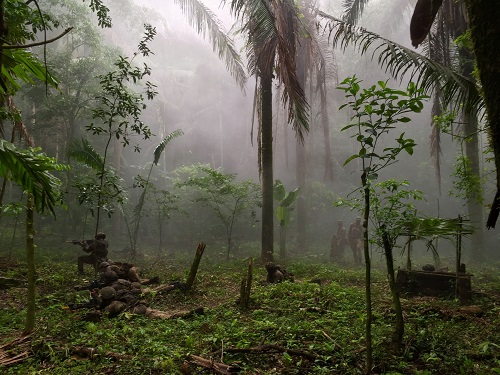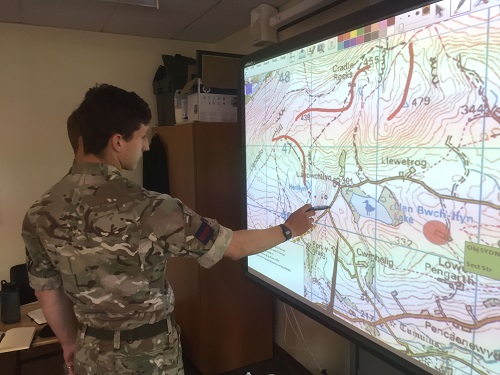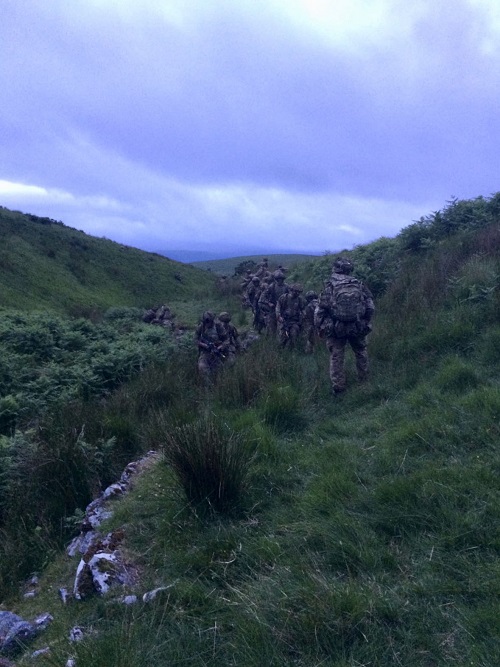Robust Leadership Development: Lessons Learned from the British Army’s Platoon Commanders’ Battle Course at the Infantry Battle School
Dustin E. Lawrence
Introduction
Last year, the author of this article participated in Operation Persistent Venture, a bilateral exchange program between the British and US Armies, during which he observed one class-cycle at the Platoon Commanders’ Division. He acted as a guest instructor throughout the PCBC, observing, assessing, and evaluating newly commissioned Second Lieutenants recently graduated from the Royal Military Academy Sandhurst.
Beyond economic and political spheres, the “special relationship” between the British and the United States significantly influenced the military history of the two great powers. And while American and British Soldiers have often shared the operational foxhole, the influence of politics, geography and public sentiment have led to noteworthy unilateral moments. The Vietnam War, the Suez Canal Crisis, and the Falklands War are potent examples. Likewise, the separate but intersecting paths have created differences in how the two nations prepare their future leaders. This is evident when comparing the initial entry courses of newly commissioned Infantry Officers – the US Infantry Basic Officer Leadership Course and the British Army’s Platoon Commanders’ Battle Course.
While most American Infantry Officers will recall the 16-week Infantry Basic Officer Leaders Course as a foundation of their war-fighting function, it is important to look at the British approach. While some differences are at odds with the US Army’s institutional approach to leadership development, there many replicable techniques to training new infantry Officers. This article will focus on the British integration of Non-Commissioned Officers to new officers’ training, field conditions, student evaluations, the student/cadre relationship, physical fitness, and student feedback at the British Army’s Platoon Commanders’ Battle Course.
The Platoon Commanders’ Battle Course at the Infantry Battle School
Following their graduation from Sandhurst, considered their Phase I training, British Second Lieutenants report to the Infantry Battle School, where they conduct their Phase II training. This phase of training includes the All Arms Live-Firing Tactical Training Course and the Platoon Commanders’ Battle Course. The LFTT qualifies the students to operate their individual weapon systems, and to conduct live-fire exercises. Following the LFTT, the students begin the 10-week tactics-based PCBC. Students are assigned to section-sized syndicates, led by a Captain (O3) and Color Sergeant (E7). Two syndicates comprise a Platoon. There are roughly twice as many instructors to students at PCBC compared to IBOLC.
During Phase II, the student’s progress from a week of fundamentals (battle-drill, weapons capabilities, and handling), to a week of section-based tactics. The next four weeks are offensive operations, followed by urban operations, then defensive operations, and urban-based company operations. These are conducted in the field at the arduous Brecon Beacons.
The final operations at PCBC are conducted during Exercise Grim Warrior, where the entire class is deployed to Belize (budget constraints may keep Exercise Grim Warrior UK-side in the future). In Belize, the students are presented with their most complicated tactical scenarios, while operating under the harshest conditions. Following Exercise Grim Warrior, the students receive their final grade and graduate. This allows them to either move onto Phase III consisting of specialty schools, or report to their unit.
Integrating Non-commissioned into the Evaluated Platoons
For five of the 10-weeks, a detail is provided from one active duty company to provide NCOs to PCBC. They fill the roles of section and team leaders during the exercises. The students operate as either riflemen, machine-gunners, signalers, or they are appointed Platoon Commander or Platoon Sergeant for evaluation. This system allows for the students to work with NCOs in their assigned roles. It also adds depth to the command appointment. Students are able to practice realistic communication with their subordinates, witnessing how those subordinates talk to Soldiers, and, ultimately, how NCOs actually operate. Some of the most palpable lessons were learned after they over-burdened their NCOs with control measures, restricting the normally aggressive NCOs from taking initiative. Likewise, they witnessed the perils of those aggressive NCOs operating without constraint on a chaotic battlefield. This left the students with a profound understanding of the art of Mission Command.
During a given class, three separate Companies from across the active British Army, provide NCOs. Both the units, and the NCOs on the assignment, hold the detail in high regard. On multiple patrols, the Platoon and Company Commanders from these units accompanied the instructors to evaluate the performance of the NCOs.
Integrating NCOs and Officers in the American institutional realm has been implemented on a limited basis before. And the results are generally positive. However, it is not regularly programmed into the US course, and students are left playing the roles of team leader, squad leader and Platoon Sergeant throughout the field problems. One comment often heard from IBOLC cadre, is that students become too familiar operating with their peers as subordinates. This creates an unrealistic training environment and causes issues with evaluation. IBOLC students don’t experience an empowered NCO, executing disciplined initiative as a subordinate leader. Without witnessing this, many students enter the larger force without a realistic understanding of their subordinate leaders’ capabilities. Having the NCO Academy provide NCOs for scenario driven phases, for instance, will allow students to better understand the core tenets of Mission Command.
Harsher Field Conditions

Students conduct a Platoon jungle attack in a Belizean jungle camp. The Platoon attack was a part of a Company attack during their culminating exercise.
Throughout the course the conditions the students operate under are thoroughly difficult. Field conditions are harsh, both in the Brecon Beacons and in Belize. In Brecon, temperatures regularly reach sub-zero. Even in the summer the temperatures may be near freezing, and precipitation is high throughout the year. In Belize the students experience the opposite conditions, operating in the equatorial heat, rain and humidity, and experiencing menacing wildlife. These conditions are far harsher than those experienced in IBOLC. They are, however, comparable to the conditions in Ranger School. But given that around half of IBOLC students pass Ranger School, it cannot be considered a shared experience amongst American Infantry Officers.
Unforgiving environments are critical to the students’ leadership development, and have historically been relied on to develop them as leaders. The harsh conditions expose the students’ character, highlighting their ability to lead under pressure. It also proves useful in the qualitative analysis of the student. While many American Infantry men will lament the heat and humidity present at Fort Benning, it pales in comparison to the conditions found in other operating environments.
Fort Benning is the home to the Maneuver Center of Excellence, however, and the ability to constantly deploy students to jungle, tundra or mountain environments is unrealistic. The advent of time, though, always harshens the infantryman’s experience. Most field problems in IBOLC last a week, with students bivouacking two to three nights. During Exercise Grim Warrior, students maintain themselves in the field for over two weeks. Combining weeks in IBOLC, would undoubtedly harden the experience and, consequently, the product.
Student Evaluations
Throughout PCBC students receive points for a cumulative grade. These point totals, however, do not determine the students’ final grade. Students are assessed to be either highly competent (A minus to A, or 85 percent to 100 percent), competent (C to B plus, or 70 to 85 percent), or not competent (F, failed to pass the assessment and scored 69 percent or below). On their final evaluation form, their class rank and final grade are annotated. Instructors, however, reserve the right to adjust the final grade. For instance, if a student earns enough points to receive a B, but their cadre determines their overall qualitative performance subpar, they have the freedom to decrease the final grade to a B minus.
This approach is also seen during the individual evaluations and command appointments. Rather than marking a “Go” or “No go” for performance measures during an appointment, instructors write a detailed description of the students’ performance based on Training Objectives and apply an overall grade. According to the PCBC Role Performance Statement, the Command Appointments “enables Instructional/Directing staff to report on the performance of an individual across the spectrum of objectives outside command and leadership roles.” In practice, instructors can apply a final grade based on unquantifiable qualities such as fortitude, authenticity, confidence, or creativity. These final grades are then sent to the gaining chain of command.
In IBOLC, the degree of qualitative placement pales to that of its British counterpart. While instructors have a pool of points reserved for their judgment, it’s of marginal weight to the outcome. PCBC’s method of assessing Command Appointments, however, places a high degree of trust in the instructor to differentiate between students who engage in theatrics, and those displaying legitimate leadership qualities. This method of assessment along with the integration of Non-commissioned Officers, and the harsh conditions, separates the robust, and authentic leaders from the inherently weak, or unmotivated ones.
Tactical Decision-making Scenarios

Students conduct route selection on a SMART Board following a lesson on terrain analysis.
Following formal class lessons on tactics, instructors create Tactical Decision-making Scenarios. These scenarios are presented on either a Smartboard, terrain-models, or the students conduct tactical exercises without troops. These are required following lessons on analysis, and battle drills. For example, following lessons on Fighting in Woods and Forest, students first conduct the battle drill first on a terrain model (see attachment 3) then over imagery on either the interactive Smartboard (see attachment 4). Following their lessons on Platoon Attack, they are moved to a small village and given an order on a small hill overlooking the village. The students create a hasty order and are socratically questioned or prompted by cadre. The exercise ends with a walkthrough of the village.
TDMSs aligns with the US Army’s Learning Model, which names optimizing the individual and collective learning as a theme (TRADOC Pamphlet 525-8-2, 3-4). The digital resourcing, and guided learning facilitates the critical thinking, which was evident during the field problem. The digital learning devices (specifically SMART Board) are commercially available and could be integrated into the current digital set-up in the American institutional domain. Far too often in TRADOC, still, generic PowerPoint presentations are relied upon. Education technology has moved well beyond Microsoft Suite in the last ten years, and the staff and instructors at PCBC take full advantage of technology readily available to primary-educators.
Physical Fitness Measures of Performance

Students conduct a tactical foot march through arduous terrain in the Brecon Beacons during an exercise called the Fan Dance. The route is also used during the selection process for the Special Air Service.
There are six physical fitness events required to complete PCBC. These are the Army Fitness Test (pushups, sit-ups, and 1.5 mile run); the Tactical Advance to Battle (an eight-mile foot march); an individual two-mile run with individual weapons, and combat gear; an individual three-mile run with individual weapons, and combat gear; a five-mile Section run with individual weapons, and combat gear; and a 24-kilometer Platoon foot march with 55-lbs through the Brecon Beacons (this is one of the three routes used during the UK Special Forces Selection Course, see attachment 1). Beyond these events, there is no collective-level physical training conducted during the course.
The AFT and TAB must be passed to enter the course. The TAB is led by a physical fitness instructor and must be completed in less than two hours. Students must and stay in formation and fail if they fallout of the movement. The two-mile and three-mile are the only scored event (two mile grading scale: “Highly Competent” is less than 16 minutes, “Competent” is 16 to 18 minutes, “Not Competent” is over 18 minutes; three-mile grading scale: HC is less than 33 minutes, C is 31 to 33 minutes, NC is over 33 minutes). The other three events factor into the students final score at the end of the course, but require participation. The 24-kilometer foot march, called the “Fan Dance,” is the definitive physical fitness event, completed in the middle of the course, before students experience compounding fatigue.
Overall, students are expected to arrive to the course in their pique physical condition. While the course is physically demanding, this is primarily because of the field exercises. The field exercises are the primary conduit towards a physically robust leader in PCBC.
Student Feedback
Student feedback is received once the course ends. This ensures the cadre don’t affect their behavior during the course based on student criticism. Still the commander of PCD maintains an open-door policy for any issues the students may have with cadre. Problems with a cadre’s approach to instruction, or evaluation are handled after the course during individual interviews with either the PCD Commander, the Battalion Adjutant, or the Commanding officer of the IBS. The primary benefit of one end-of-course evaluation is a consistent demeanor from the cadre, who are not pressured to change their behavior for positive feedback.
Conclusion
The overall caliber of student arriving to PCBC from the Royal Military Academy Sandhurst is high. Only the top thirty percent of Sandhurst students are qualified to become Infantrymen. However capable these students arrive, they are assisted most in their leader development by the integration of NCOs, while in harsh and unforgiving environments. The TDMS greatly contribute to not only their understanding of the battle drills, but their application, and ultimately their adaptability when complexity arises. Their physical robustness and ability to lead under pressure doesn’t arise because of a regimented physical fitness plan, rather by the miles they walk under heavy loads, and the constant pressure by the opposition forces during exercises. Through these experiences the most capable leaders are evident, and PCBC cadre rate them accordingly for their future battalion commanders, who directly receive the students’ final evaluation. Following the British student’s graduation from the course, the cadre at PCBC are generally confident in their product. As are the company and battalion commanders in receiving their newly minted platoon commanders.
About the Author(s)
Comments
If for some reason, you do…
If for some reason, you do not want to choose 99papers reddit based on reviews company, then I have a few more options that are definitely worth your attention. Go PM.
Honestly, I always bypass…
Honestly, I always bypass articles with political overtones, as I try to remain neutral in this topic. Even when I have to write essays on such a subject in college, I cannot do without help Rush My Essay And your article interested me. It was very interesting to read.
